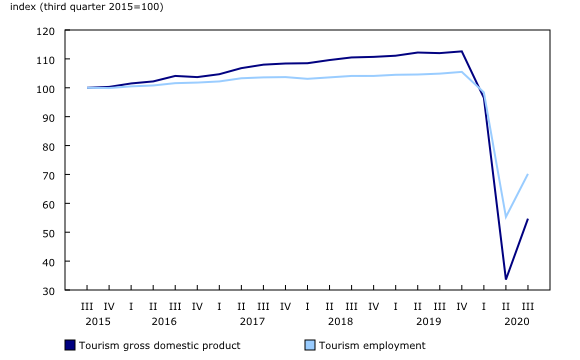National tourism indicators, third quarter 2020
Archived Content
Information identified as archived is provided for reference, research or recordkeeping purposes. It is not subject to the Government of Canada Web Standards and has not been altered or updated since it was archived. Please "contact us" to request a format other than those available.
Released: 2021-01-08
Tourism spending in Canada rose during the third quarter but remained less than half (-52.9%) its level in the fourth quarter of 2019. The 56.4% increase partially offset the large declines in the first (-14.0%) and second (-65.0%) quarters. Tourism gross domestic product (GDP) and jobs attributable to tourism were also up from the second quarter but remained well below pre-pandemic levels.
All tourism spending categories posted double-digit growth or greater from the historic lows of the second quarter. Despite more than doubling (+131.7%), passenger air transport remained the hardest hit spending category, with levels 89.9% lower than in the fourth quarter of 2019.
Tourism GDP increased in the third quarter (+62.6%), following record declines in the first (-14.3%) and second (-65.2%) quarters. Despite this increase, tourism GDP remained 51.5% lower than in the fourth quarter of 2019. Economy-wide GDP rose 8.9% from the previous quarter but was down 5.3% from the fourth quarter of 2019. Tourism's share of GDP rose from 0.7% in the second quarter to 1.0% in the third but was still well below the pre-pandemic level (2.0%).
Employment attributable to tourism rose 27.1% in the third quarter, following declines in the first (-6.7%) and second (-43.8%) quarters. The increase was driven mainly by more jobs in food and beverage services (+47.2%), accommodation (+39.3%), and non-tourism industries (+26.1%), which all registered significant losses in the second quarter. Growth was constrained by lower employment in air transportation (-8.5%). Overall, employment in Canada rose 19.3% in the third quarter, and, as a result, tourism's share of jobs rose to 2.8%.
Tourism spending in Canada by Canadians increases
Tourism spending in Canada by Canadians rose 56.9% in the third quarter, recouping some of the 56.8% decline from the previous quarter. Nevertheless, compared with the fourth quarter of 2019, domestic tourism spending was down 40.6%.
Domestic tourism spending accounted for 98.6% of total tourism spending in the third quarter, slightly higher than the 98.3% recorded in the second quarter, as Canadians increased their tourism spending in Canada at a faster pace than international visitors. This compares with an average domestic tourism spending share of 79.1% from 2014 to 2019.
Spending by international visitors remains low
Tourism spending by international visitors to Canada rose 28.2% in the third quarter, following a second quarter (-97.1%) devastated by travel restrictions. Despite the large quarterly growth, spending was down 97.0% compared with the fourth quarter of 2019.
Sustainable development goals
On January 1, 2016, the world officially began implementing the 2030 Agenda for Sustainable Development—the United Nations' transformative plan of action that addresses urgent global challenges over the next 15 years. The plan is based on 17 specific sustainable development goals.
The national tourism indicators are an example of how Statistics Canada supports the reporting on the global goals for sustainable development. This release will be used in helping to measure the following goal:

Note to readers
Growth rates for tourism spending and gross domestic product (GDP) are expressed in real terms (that is, adjusted for price changes), using reference year 2012, as well as adjusted for seasonal variations, unless otherwise indicated.
Employment data are also seasonally adjusted.
Tourism's share of economy-wide GDP is calculated from seasonally adjusted nominal values.
Tourism's share of economy-wide employment is calculated using seasonally adjusted values.
For information on seasonal adjustment, see Seasonally adjusted data – Frequently asked questions.
Associated percentage changes are presented at quarterly rates unless otherwise noted.
Economy-wide GDP is obtained from table 36-10-0104-01. Economy-wide employment is obtained from table 36-10-0207-01.
With the third quarter release of the national tourism indicators, data for the first and second quarters have been revised.
The national tourism indicators are funded by Destination Canada.
Next release
Data on the national tourism indicators for the fourth quarter of 2020 will be released on March 31, 2021.
Products
The data visualization product "Provincial and Territorial Tourism Satellite Account," which is part of Statistics Canada – Data Visualization Products (71-607-X), is available.
The Economic accounts statistics portal, accessible from the Subjects module of our website, features an up-to-date portrait of national and provincial economies and their structure.
The Latest Developments in the Canadian Economic Accounts (13-605-X) is available.
The User Guide: Canadian System of Macroeconomic Accounts (13-606-G) is available.
The Methodological Guide: Canadian System of Macroeconomic Accounts (13-607-X) is available.
Contact information
For more information, or to enquire about the concepts, methods or data quality of this release, contact us (toll-free 1-800-263-1136; 514-283-8300; STATCAN.infostats-infostats.STATCAN@canada.ca) or Media Relations (613-951-4636; STATCAN.mediahotline-ligneinfomedias.STATCAN@canada.ca).
- Date modified:





